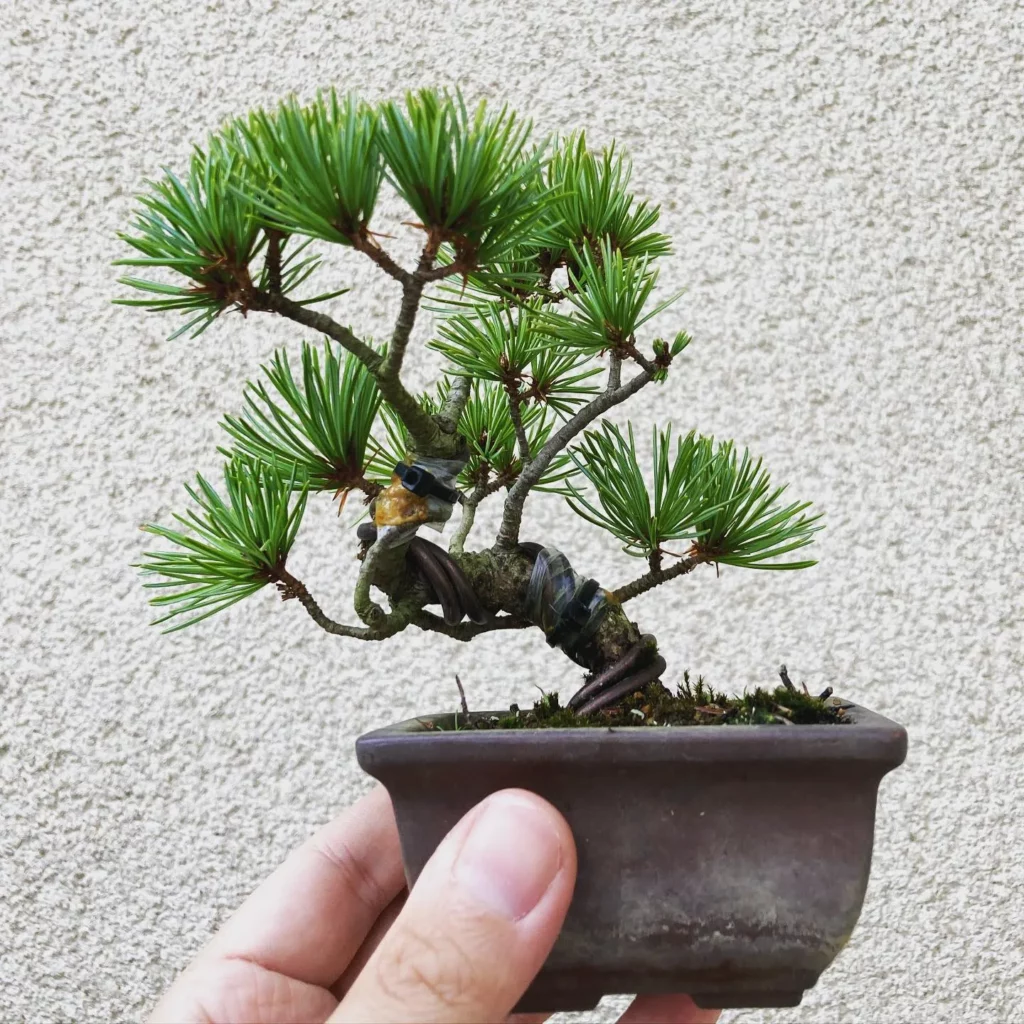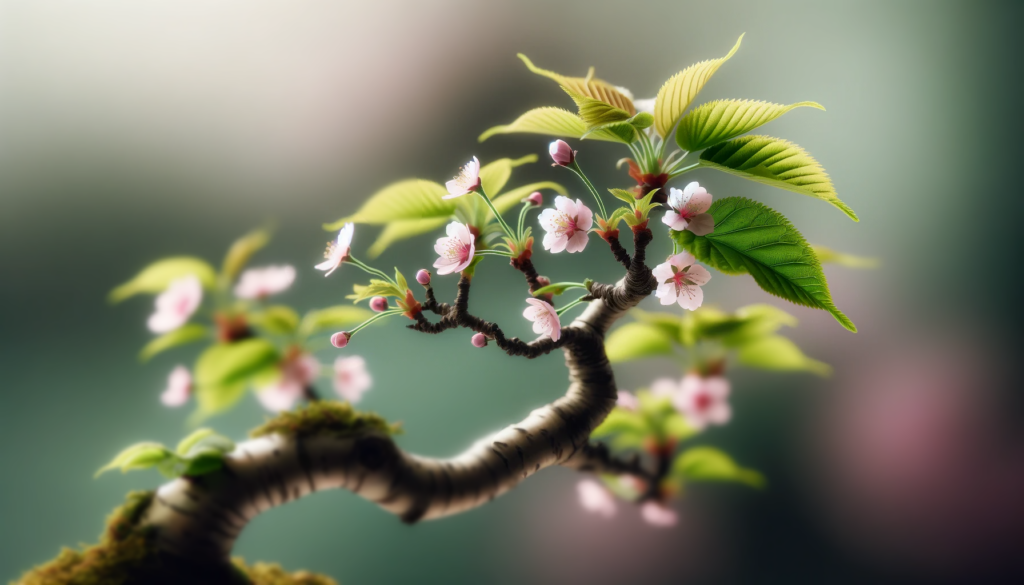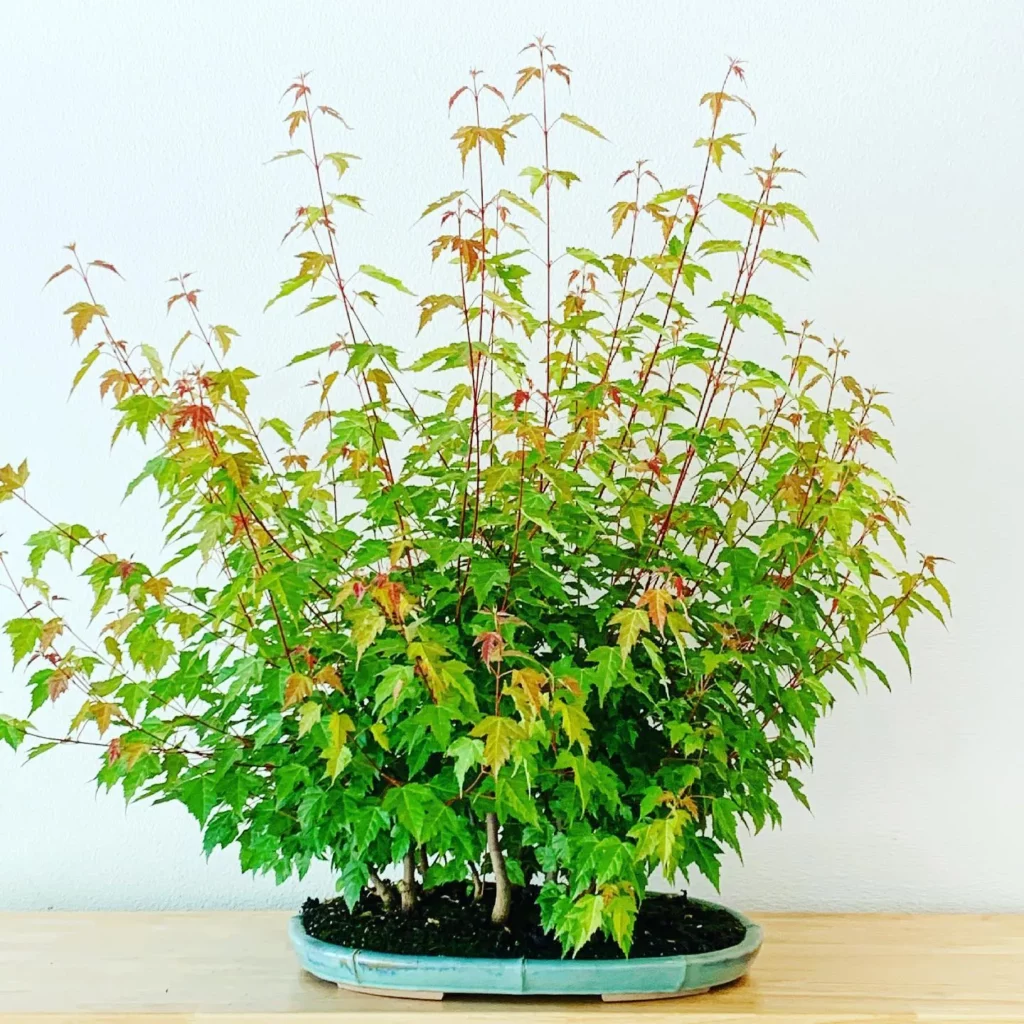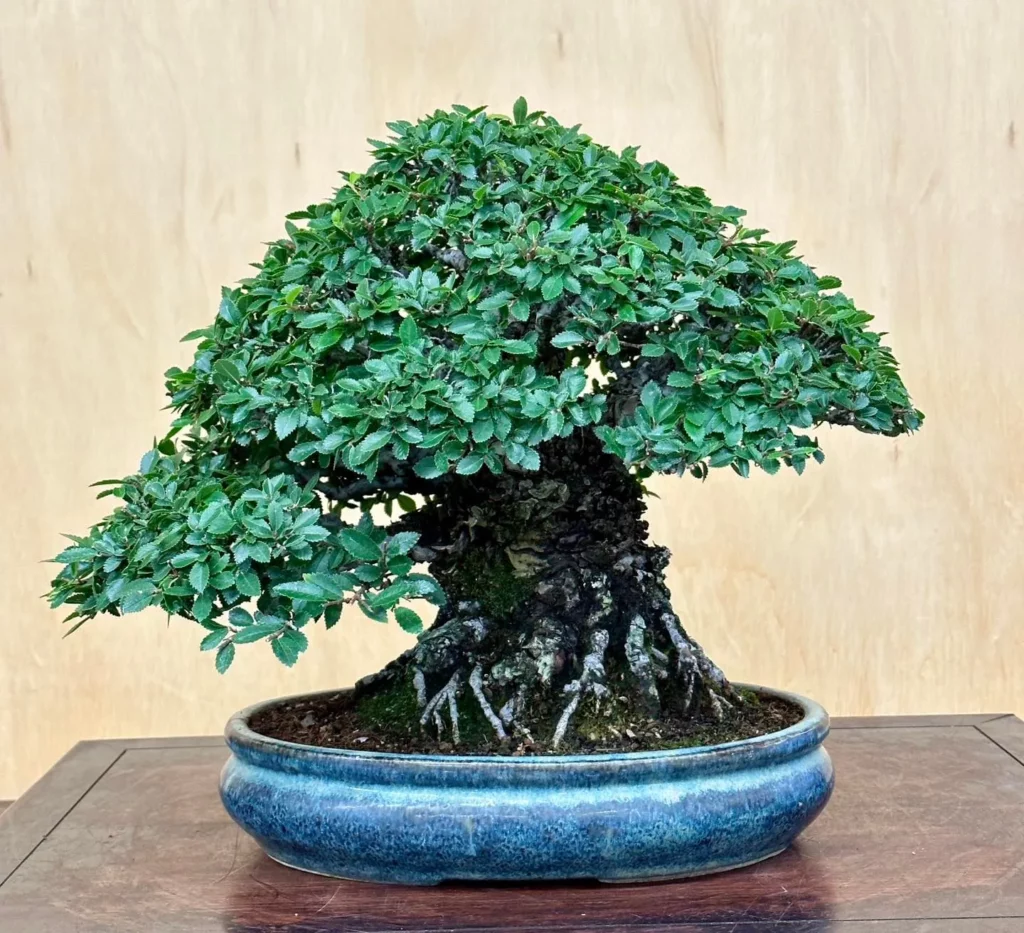Shohin Bonsai is a type of miniature bonsai tree known for its stunning elegance and small size. Standing no taller than 8 inches, these tiny trees possess all the intricacies and charm of their larger counterparts. With proper care, Shohin Bonsai can thrive and bring a touch of elegance to even the smallest spaces.
Understanding Shohin Bonsai



Shohin Bonsai is a smaller version of a traditional bonsai tree, typically measuring between 10-20 cm in height. It possesses all the elements of a full-sized bonsai, including small leaves, thin trunks, and delicate branches. Compared to Mame Bonsai, Shohin Bonsai is larger and requires slightly different care due to its size. It is important to understand the characteristics and differences between these two types of miniature trees to choose the right one for your preferences and living conditions.
Ideal Growing Conditions for Shohin Bonsai



Shohin Bonsai, like all plants, thrives when provided with the ideal growing conditions. By creating a suitable environment, you can ensure that your Shohin Bonsai stays healthy and grows beautifully. Here are the key factors to consider:
- Humidity: Shohin Bonsai prefers humid environments, as it mimics their natural habitat. You can increase humidity by misting the leaves regularly or placing the tree on a tray filled with water and pebbles.
- Light: While Shohin Bonsai requires sufficient light for growth, it is best to provide partial shade or bright indirect sunlight. Direct light exposure can scorch the leaves, so it is important to find the right balance.
- Drainage: Good drainage is essential for Shohin Bonsai. Ensure that the pot has drainage holes to prevent water from accumulating. Excess water can lead to root rot and other issues.
- Soil: Use a well-draining soil mix that retains moisture without becoming waterlogged. The recommended pH level for Shohin Bonsai is around 6-6.5. There are specialized bonsai soil mixes available that provide the ideal conditions for growth.
Choosing the Right Soil Mix for Shohin Bonsai



The soil mix plays a crucial role in ensuring the health and vitality of your Shohin Bonsai. It should provide the right balance of drainage, oxygen, and nutrients to support the tree’s delicate roots. When choosing a soil mix for your Shohin Bonsai, consider the following options:
No products found.
- Akadama: This clay-like soil is a popular choice for bonsai enthusiasts. It retains moisture while also providing excellent drainage, allowing oxygen to reach the roots.
- Pumice: Pumice is a volcanic rock that is lightweight and porous. It helps create a well-draining soil mix that prevents waterlogging and promotes root health.
- Lava Rock: Lava rock is another porous material that is commonly used in bonsai soil mixes. It provides good aeration and prevents compacting, allowing the roots to breathe and absorb nutrients.
- Organic Soil Mixes: These mixes contain organic materials such as compost, coco coir, or peat moss, which help retain moisture and provide nutrients. They can be beneficial when used in combination with inorganic components for creating a well-balanced soil mix.
Alternatively, you can create a custom soil mix by combining different materials based on your Shohin Bonsai’s specific needs. The key is to balance water retention and drainage while providing essential nutrients for healthy root growth. Experimenting with different soil mixes can help you find the perfect combination for your Shohin Bonsai. Remember to monitor the moisture levels and adjust your watering schedule accordingly. By choosing the right soil mix, you can ensure the long-term health and vitality of your Shohin Bonsai.
Watering Techniques for Shohin Bonsai



Proper watering is crucial for the health and vigor of Shohin Bonsai. These miniature trees have a small root system and are more susceptible to dehydration. Regular watering is essential to maintain their well-being.
The frequency and amount of water depend on several factors:
- Pot size: Smaller pots dry out more quickly, requiring more frequent watering.
- Soil mix: Well-draining soil ensures proper water absorption and prevents waterlogged roots.
- Temperature: Higher temperatures increase the rate of evaporation, necessitating more frequent watering.
- Humidity levels: Dry environments require more frequent watering to compensate for moisture loss.
- Sun exposure: Bonsai trees in direct sunlight may require more water than those in partial shade.
It is important to water Shohin Bonsai when the soil surface feels dry to the touch. This indicates that the tree is ready for watering. Use your finger to check the moisture level by gently pressing it into the soil.
When watering, ensure thorough watering without overwatering. Keep pouring water until it begins to drain out from the bottom of the pot, indicating that the entire root system is adequately hydrated. This helps to prevent waterlogged roots and promotes healthy growth.
Fertilizing Shohin Bonsai



Fertilizing Shohin Bonsai is vital for promoting healthy foliage growth and maintaining the overall well-being of the tree. To provide the necessary nutrients, it is recommended to use balanced bonsai fertilizers. These fertilizers contain the perfect ratio of nitrogen, phosphorus, and potassium, ensuring optimal growth and development.
The frequency of fertilizing Shohin Bonsai depends on the specific fertilizer used. In general, fertilizing should be done every 2-4 weeks during the growing season. This ensures that the tree receives a steady supply of nutrients for sustained growth. It is crucial to follow the instructions provided by the manufacturer regarding dosage and application.
When fertilizing Shohin Bonsai, it’s important to adjust the dosage based on the tree’s needs. It is better to under-fertilize than to over-fertilize, as excessive amounts of fertilizer can harm the tree. Observing the tree’s growth rate and overall health can help determine if any adjustments need to be made in the fertilizing routine.
Potting Shohin Bonsai
Potting is a crucial aspect of caring for your Shohin Bonsai. It ensures that the tree has fresh soil, promotes healthy root growth, and maintains its compact size. Repotting should be done every 2-3 years to provide the best conditions for your bonsai.
When it’s time to repot your Shohin Bonsai, choose a well-draining potting mix that will help maintain proper moisture levels and allow for adequate oxygenation. Using a mix specifically designed for bonsai trees will ensure the best results. Such a mix will typically consist of components like akadama, pumice, and lava rock.
Before repotting, carefully remove the tree from its current container. Inspect the roots and trim any that have become too long or tangled. Trimming the roots not only helps manage their size but also encourages new root growth and overall tree health.
When placing the bonsai back in its new pot, ensure that it is positioned at the right depth. The top of the root ball should be slightly below the rim of the pot, allowing for room to add a fresh layer of soil. Gently fill in the gaps around the roots with the potting mix, being careful not to compact it too much.
Potting Shohin Bonsai: Step-by-Step Guide
- Choose a container with adequate drainage holes that is slightly larger than the current pot.
- Prepare the potting mix by using a blend of akadama, pumice, and lava rock.
- Carefully remove the bonsai from its current pot, being mindful of the root system.
- Inspect the roots and trim any that are too long or tangled.
- Position the bonsai in the new pot, ensuring it is placed at the right depth.
- Gently fill in the gaps around the roots with the potting mix, avoiding excessive compaction.
- Water the bonsai thoroughly after potting to settle the soil and promote root establishment.
Propagation of Shohin Bonsai


Interested in expanding your collection of Shohin Bonsai? Propagation is the key to creating new trees and exploring different species and varieties. There are several methods you can use to propagate Shohin Bonsai:
- Seed Germination: Planting Shohin Bonsai seeds in a suitable growing medium and providing the right conditions for germination.
- Cutting: Taking a cutting from a healthy Shohin Bonsai tree and encouraging it to develop roots to become an independent tree.
- Air Layering: Encouraging the growth of roots on a branch of an existing Shohin Bonsai tree while it is still connected to the main tree. After the roots develop, the branch can be separated and potted as a new tree.
- Grafting: Attaching a small piece of one Shohin Bonsai tree onto another tree, allowing it to grow together and form a new tree with desirable characteristics.
Growth and Development of Shohin Bonsai
Shohin Bonsai, although smaller in size, offers a unique advantage when it comes to the growth and development of these miniature trees. Due to their slower growth rate compared to larger bonsai trees, Shohin Bonsai allows for intricate details and refinement in their structure. With regular pruning and training, you can guide the growth and shape of your Shohin Bonsai, resulting in a well-shaped canopy of leaves, twisted trunks with exposed roots, and even bark patterns that mimic the aged trees found in nature.
Patience plays a crucial role in the growth and development of Shohin Bonsai. These delicate trees require careful care and attention to ensure their healthy progress. By providing the right amount of light, proper watering techniques, and well-balanced fertilization, you can nurture your Shohin Bonsai to reach its full potential. It’s important to observe and respond to the tree’s specific needs, making adjustments and modifications along the way to promote its optimal growth.
To aid in the growth and development of your Shohin Bonsai, here are some essential tips:
Regular Pruning
- Prune your Shohin Bonsai regularly to maintain its desired shape and encourage branching.
- Remove any dead or damaged branches using sharp, sterile pruning tools.
- Trim back excessive growth to maintain the miniature proportions of the tree.
Training Techniques
- Use wire to gently shape and guide the branches of your Shohin Bonsai.
- Be careful not to leave the wire on for too long, as it may cause damage or scarring.
- Gradually adjust the wire every few months to prevent it from digging into the trunk or branches.
Regular Inspections
- Monitor your Shohin Bonsai for any signs of pests or diseases.
- Inspect the leaves, branches, and soil regularly, looking for abnormalities or changes.
- If you notice any issues, take immediate action to address and resolve them.
Dealing with Pests and Diseases in Shohin Bonsai
Like any plant, Shohin Bonsai is susceptible to pests and diseases. It is important to be vigilant and take necessary measures to protect the health of your bonsai tree.
Pests
Common pests that can affect Shohin Bonsai include aphids, scale insects, and spider mites. These tiny creatures can cause damage to the leaves and stems of your bonsai tree if left unchecked.
No products found.
- Aphids: These small insects feed on the sap of the bonsai tree, causing yellowing leaves and stunted growth. To control aphids, you can use insecticidal soap or neem oil.
- Scale insects: Scale insects can appear as small bumps on the leaves or stems of your bonsai tree. They can weaken the tree and lead to leaf drop. You can remove scale insects manually or use horticultural oil to suffocate them.
- Spider mites: Spider mites are tiny pests that spin webs and extract sap from the bonsai tree’s leaves. They can cause yellowing and drying of the foliage. Regular misting and using insecticidal soap can help control spider mites.
Diseases
Common diseases that can affect Shohin Bonsai include root rot and fungal infections. These diseases can weaken the tree and inhibit its growth if not addressed promptly.
- Root rot: Root rot occurs when the roots of the bonsai tree are constantly exposed to excess moisture, leading to decay. To prevent root rot, ensure proper drainage and avoid overwatering your bonsai tree. If root rot occurs, you may need to repot the tree using fresh, well-draining soil.
- Fungal infections: Fungal infections can manifest as discolored spots on the leaves or a white, powdery substance. To prevent fungal infections, ensure good airflow around your bonsai tree and avoid overhead watering. If a fungal infection occurs, you can use a fungicide recommended for bonsai trees.
Enjoying the Beauty of Shohin Bonsai
By providing proper care, Shohin Bonsai can grow into stunning works of art that bring beauty and tranquility to any space. The miniature size and graceful elegance of Shohin Bonsai make it a captivating addition to any collection. Whether displayed on a desk, table, or shelf, these exquisite trees create a sense of serenity and harmony in your surroundings.
With their intricate details and refined structure, Shohin Bonsai are like living sculptures that showcase the beauty of nature in a compact form. Each carefully pruned branch and every perfectly formed leaf contribute to the overall aesthetic appeal. It’s truly a joy to witness these miniature creations develop and evolve over time.
Immersing yourself in the enchanting world of Shohin Bonsai allows you to experience the calming effect of nature firsthand. As you observe their growth and meticulously care for them, you’ll develop a deep appreciation for their delicacy and artistry. Each Shohin Bonsai tells a unique story and invites you to connect with nature in a new and intimate way.
FAQ
What is Shohin Bonsai?
Shohin Bonsai is a type of miniature bonsai tree that is no larger than 8 inches in height. It is known for its compact size and stunning beauty.
How big does Shohin Bonsai typically grow?
Shohin Bonsai typically measures between 10-20 cm in height, making it a smaller version of a traditional bonsai tree.
What are the ideal growing conditions for Shohin Bonsai?
Shohin Bonsai thrives in humid environments with adequate drainage systems. It prefers partial shade or bright indirect sunlight and well-draining soil with a pH level of around 6-6.5.
What type of soil mix should I use for Shohin Bonsai?
Popular options for creating a suitable soil mix for Shohin Bonsai include Akadama, Pumice, Lava Rock, and Organic Soil Mixes. You can also create a custom soil mix by combining organic and gritty materials.
How often should I water my Shohin Bonsai?
Water your Shohin Bonsai when the soil surface feels dry to the touch, ensuring thorough watering without overwatering. The frequency and amount of water depend on factors such as pot size, soil mix, temperature, humidity levels, and sun exposure.
How often should I fertilize my Shohin Bonsai?
Fertilize your Shohin Bonsai every 2-4 weeks during the growing season using balanced bonsai fertilizers that contain the necessary ratio of nitrogen, phosphorus, and potassium.
When should I repot my Shohin Bonsai?
Repot your Shohin Bonsai every 2-3 years to provide fresh soil, promote root health, and maintain the compact size of the tree.
How can I propagate Shohin Bonsai?
Shohin Bonsai can be propagated through methods such as seed germination, cutting, air layering, and grafting.
How can I ensure the growth and development of my Shohin Bonsai?
Regular pruning and training are essential for the growth and development of Shohin Bonsai. With patience and careful care, you can shape your bonsai into a well-structured tree.
How can I prevent pests and diseases in my Shohin Bonsai?
Regular inspection, early detection, and proper watering and airflow can help prevent pests and diseases in Shohin Bonsai. Organic or chemical treatments can be used to control pests as necessary.
How can I enjoy the beauty of my Shohin Bonsai?
By providing proper care, Shohin Bonsai can grow into stunning works of art that bring beauty and tranquility to any space. Display it on a desk, table, or shelf and enjoy the enchanting world of Shohin Bonsai.




